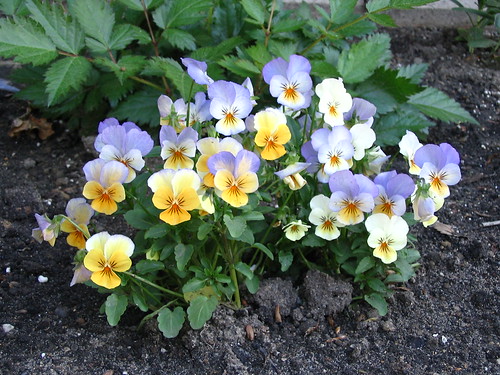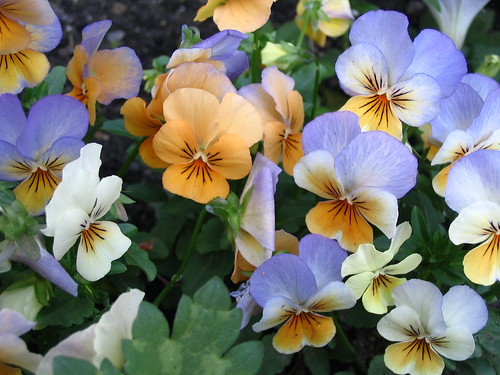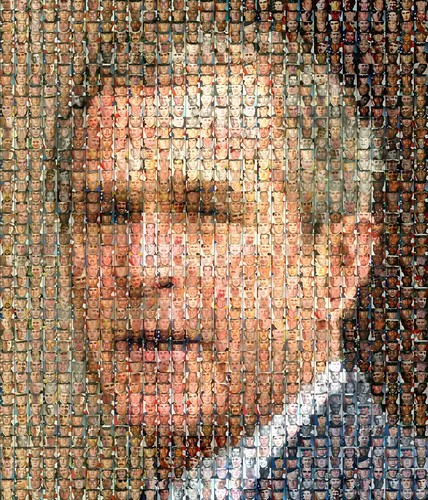Scales of Flowers
Here are two pictures of flowers. In case you care, I'll let
you know that these flowers can be found on the north side of the
Michigan Union, on the University of Michigan campus. You
might also want to know what kind of flowers they are, but you will
have to wait.


I studied anthropology and zoology, not botany, so don't ask me the name of the flowers. I can't answer that question. So I will move on to a different question.
Notice that one picture was taken from about two feet away; the other, from just a few inches. So which is the better picture?
I did not study art, so I cannot answer that question. But I can say what I like...
The closer-up one is more appealing to me, when looking at it on the computer monitor. However, it occurred to me, that if I were to get one of the pictures printed and framed and hung on the wall, I would rather have the one that shows the whole bunch.
If I had printed the picture that gave me the best impression at first, I would have ended up with the wrong one on the wall.
What this demonstrates, is that one picture is better for one particular purpose, while the other is better for a different purpose. Yet is is almost automatic, to ask ourselves: "which one is better?" We conclude that something is good or bad, better or worse; then, we base our subsequent decisions on that conclusion. In the process, we forget what observations led us to the conclusion in the first place.
That is one way that we end up making the wrong choices. We base our decisions on intermediate conclusions; then we forget the original observations.
Often, when we consider a bunch of observations, then draw some kind of conclusion, we think we have gained new information. That is not the case. Conclusions tend to obscure information, not generate new information.
Politicians know this. That is why they so often try to get us to draw conclusions prematurely. They try to get us to form a positive impression of them, based on vague niceties. We draw a conclusion, and feel good about ourselves, thinking we have figured something out. We often don't bother to notice when subsequent observations don't fit with our nice little conclusion. After we form that initial impression, we tend to disregard the little details. After all, why go through the effort of noticing and/or remembering all those little details, when you already know what your conclusion is?
Well, the reason is this: you might end up with the wrong picture on the wall.


I studied anthropology and zoology, not botany, so don't ask me the name of the flowers. I can't answer that question. So I will move on to a different question.
Notice that one picture was taken from about two feet away; the other, from just a few inches. So which is the better picture?
I did not study art, so I cannot answer that question. But I can say what I like...
The closer-up one is more appealing to me, when looking at it on the computer monitor. However, it occurred to me, that if I were to get one of the pictures printed and framed and hung on the wall, I would rather have the one that shows the whole bunch.
If I had printed the picture that gave me the best impression at first, I would have ended up with the wrong one on the wall.
What this demonstrates, is that one picture is better for one particular purpose, while the other is better for a different purpose. Yet is is almost automatic, to ask ourselves: "which one is better?" We conclude that something is good or bad, better or worse; then, we base our subsequent decisions on that conclusion. In the process, we forget what observations led us to the conclusion in the first place.
That is one way that we end up making the wrong choices. We base our decisions on intermediate conclusions; then we forget the original observations.
Often, when we consider a bunch of observations, then draw some kind of conclusion, we think we have gained new information. That is not the case. Conclusions tend to obscure information, not generate new information.
Politicians know this. That is why they so often try to get us to draw conclusions prematurely. They try to get us to form a positive impression of them, based on vague niceties. We draw a conclusion, and feel good about ourselves, thinking we have figured something out. We often don't bother to notice when subsequent observations don't fit with our nice little conclusion. After we form that initial impression, we tend to disregard the little details. After all, why go through the effort of noticing and/or remembering all those little details, when you already know what your conclusion is?
Well, the reason is this: you might end up with the wrong picture on the wall.


 :
Joseph j7uy5
:
Joseph j7uy5
<< Home